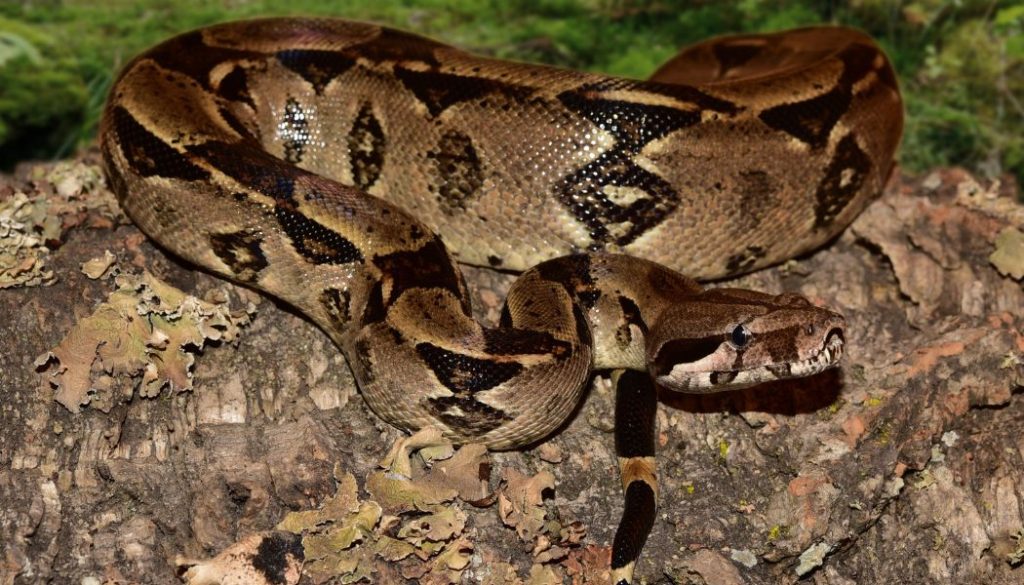The red tails in red tail boas are a result of specific genetic factors that dictate the types and amounts of pigments in their skin, primarily melanin and carotenoids. While the definitive purpose of the red tail isn’t fully understood, theories suggest it may serve to deter predators or possibly play a role in sexual selection.
The color is often more vivid in younger boas and tends to fade as they mature. Research is ongoing, but the red tail certainly adds to the snake’s mystique and allure.
Ever wondered why these snakes sport that mesmerizing red tail?
You’re not alone! In this comprehensive article, we’ll delve into the biology, significance of coloration, myths, and the actual science behind this unique feature.
We’ll even touch upon the possible role it plays in mating. Plus, we’ve got a handy FAQ section to tackle your burning questions. Ready to unravel the mystery of the red tail boa?
Let’s dive in!

Table of Contents
Brief Biology of the Red Tail Boa
The Name and Natural Habitat
Hey there, snake enthusiasts and curious minds alike! So you’re wondering why red tail boas have those flashy red tails, huh? Before we unravel this enigma, let’s get to know the red tail boa a little better. First off, the red tail boa’s official name is Boa constrictor constrictor.
Quite a mouthful, isn’t it? These majestic creatures hail from Central and South America, where they slither through rainforests, swamps, and grasslands. They’re pretty adaptable; whether it’s the canopy or the forest floor, they make themselves at home.
Physical Features and Size
Now, let’s talk size and features. A fully-grown red tail boa can stretch up to an impressive 10 feet. Yes, you heard that right!
But don’t worry, most average between 5 to 7 feet, which is still pretty darn impressive if you ask me. They’ve got thick, muscular bodies covered in intricate patterns, and of course, that head-turning red tail.
Special Abilities
Oh, and let’s not forget those heat-sensing pits near their mouths, which they use to detect prey. Think of them as nature’s thermal cameras.
Diet and Hunting Techniques
And what do they eat? Well, their diet mainly consists of small to medium-sized mammals and birds. They are ambush predators, lying in wait for the opportune moment to strike.
Once they latch onto their prey, they use their powerful coils to constrict and suffocate it. Nature is both beautiful and brutal, isn’t it?
The Significance of Coloration in Snakes
Why Color Matters
Alright, so now that we know a bit more about the red tail boa’s biology, let’s talk color. Because, let’s face it, coloration isn’t just for show; it plays a crucial role in a snake’s life. In the animal kingdom, color serves a bunch of functions, like camouflage, communication, and even thermoregulation.
Types of Coloration
Among snakes, you’ll find a myriad of color patterns. There’s countershading, where the belly is lighter than the back, helping the snake blend in with its surroundings when viewed from different angles.
Then you’ve got banding, striping, and blotching, which can help break up the outline of the snake, making it harder to spot. It’s like their own built-in invisibility cloak!
Red Tails in Context
Now, where does the red tail of the boa fit into this colorful tapestry? Could it be for camouflage? Or perhaps it serves as a warning?
The intriguing part is that the red tail is often more vivid in juveniles and tends to fade as the snake matures. So, the function of the red tail could very well differ across the boa’s lifespan. A tantalizing thought, isn’t it?
The Mythology and Folklore Surrounding the Red Tail
Stories from Native Tribes
Now, let’s dig into something really fascinating—the stories and legends that surround the red tail boa. Indigenous tribes in South America have various beliefs about these snakes. Some view them as protectors of the forest, while others see them as omens.
Symbolism and Beliefs
The red tail itself often carries special significance in these tales. For instance, in some cultures, the red symbolizes life force, energy, or even the spirit world. Imagine being so cool that entire cultures write stories about you!
Modern Interpretations
Interestingly, the symbolism doesn’t stop at folklore. In the modern age, the red tail boa is often associated with mystique and allure. Thanks to their striking appearance, they’ve made their way into popular culture, sometimes serving as powerful symbols in literature and art.
The Actual Science Behind the Red Tail
Genetic Factors at Play
Ready for some real science? Great! The coloration of the red tail boa isn’t just an accident; it’s a result of specific genetic factors. Genes dictate the types and amounts of pigments in the snake’s skin.
In the case of the red tail boa, two primary pigments are at play: melanin, which gives the dark color, and carotenoids, which are responsible for the red hue.
The Role of Pigments
These pigments are arranged in specialized cells called chromatophores. It’s like nature’s own palette! Melanin gives depth and darkness, while carotenoids provide that stunning red. The interplay between these pigments creates the vivid tail color we all find so captivating.
Evolutionary Advantage or Not?
Now, let’s get into the $1 million question: Is there an evolutionary advantage to this red tail? Well, research is still a bit sparse, but some theories suggest that the red tail could help in deterring predators.
The color red is often associated with danger or toxicity in the animal kingdom, after all. Other theories propose that the red tail could be linked to sexual selection, but more on that in the next section.
The Red Tail and Mating
Is Red the Color of Love?
Time to talk romance—or at least, the snake version of it. In the animal world, color often plays a vital role in attracting a mate. It’s like wearing your best outfit to a date! Now, you might be thinking: Do red tail boas use their red tails to attract partners? The answer is, it’s complicated.
Sexual Dimorphism and the Red Tail
In many snake species, there’s something called sexual dimorphism, where males and females have distinct physical traits. However, in red tail boas, both sexes sport the red tail, making it unlikely that the coloration is used for sexual signaling among these snakes.
The Mating Puzzle
Although the red tail may not play a direct role in mating, its presence could still offer some advantages. It could serve as an indicator of good health or superior genetics, making the red-tailed boa more appealing to a potential mate.
Still, research in this area is ongoing, and definitive answers are elusive.
Conclusion
You’ve journeyed through the fascinating world of the red tail boa, uncovering its biology, the significance of its coloration, and the myths and science that surround this intriguing feature.
Whether it’s genetics, evolutionary advantage, or cultural symbolism, the red tail continues to captivate our imagination.
While definitive answers are still elusive, the quest for knowledge is what makes science so exciting.
So keep asking questions and stay curious—you’re part of the journey to unravel the enduring mysteries of the natural world!
FAQ
What is the difference between a red tail boa and a common boa?
Ah, the age-old question! So, both red tail boas and common boas belong to the genus Boa, but they’re distinct subspecies. The red tail boa (Boa constrictor constrictor) typically has more vivid coloration, including that iconic red tail. Common boas (Boa constrictor imperator) are usually less colorful and can have different patterns.
Where do red tail boas come from?
Geography lesson, anyone? Red tail boas are native to Central and South America. They love hanging out in a range of habitats—from rainforests to grasslands. You could say they’re quite the adaptable bunch!
How do I identify my boa?
Identification, the detective work of the snake world! To identify a red tail boa, look for a thick body, intricate patterns, and, of course, the red tail. Juveniles tend to have more vivid tails, so keep that in mind.
What are the different types of boa?
Oh, the world of boas is a kaleidoscope! Apart from the red tail and common boas, there are also species like the Boa constrictor occidentalis, the Argentine boa, and the Boa constrictor longicauda, the long-tailed boa. Each has its own unique characteristics and preferred habitats.




0 Comments